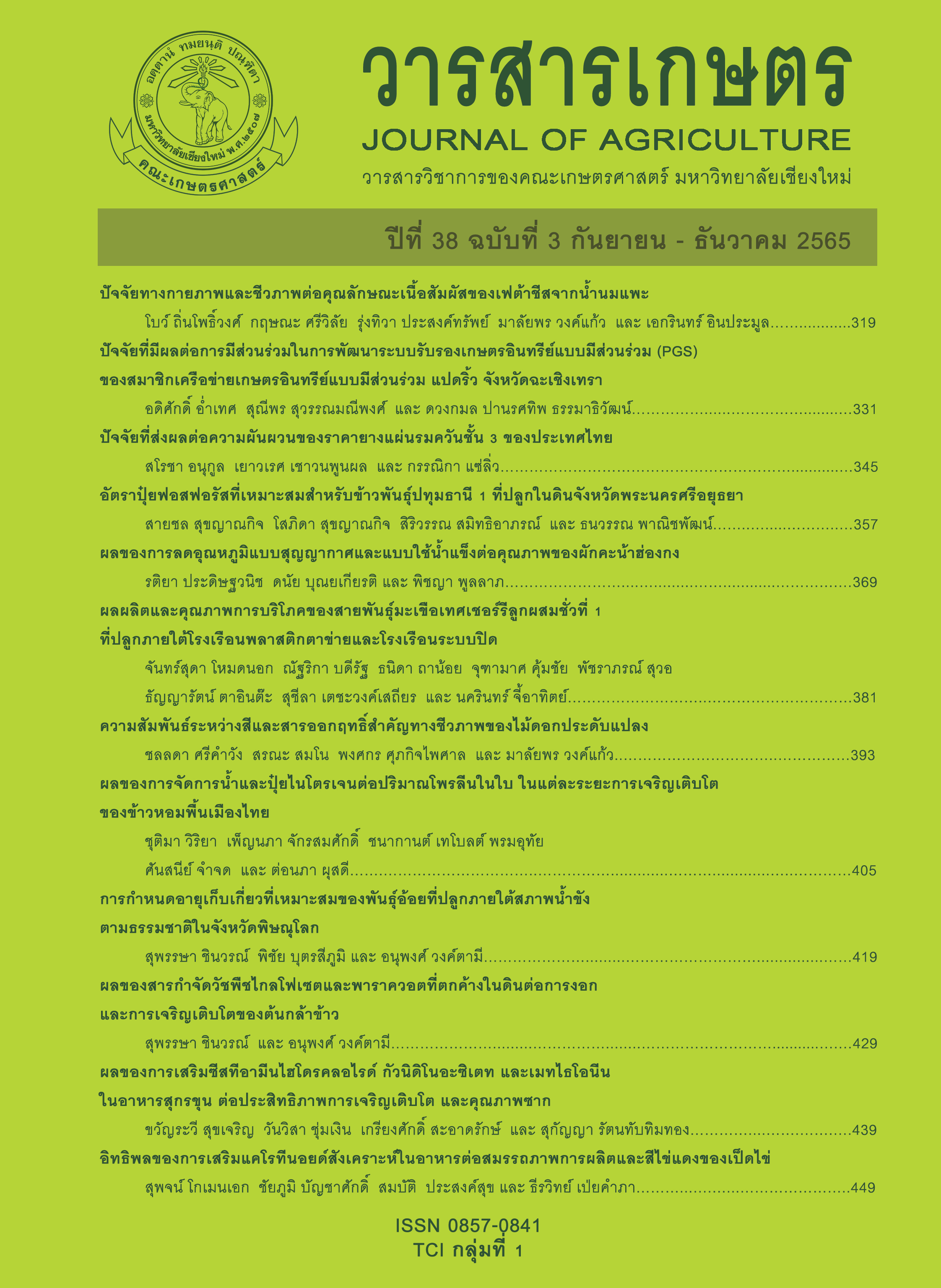Influence of Synthetic Carotenoids Supplementation in Feed on Production Performance and Egg Yolk Color of Laying Ducks
Main Article Content
Abstract
The objective of this study was to study the effect of synthetic carotenoids on the egg yolk color intensity of laying ducks. A total of 1,500 Khaki Campbells laying ducks, aged 23 weeks, were used. The ducks were divided into 6 groups, each with 5 subgroups of 50 ducks each. The laying ducks were 26 weeks old when the experiment began. The experiments were planned to use a completely randomized design method. The 6 experimental groups were classified based on their dietary treatment as follows: 1. Basal feed (without carotenoids supplementation); 2. Basal feed with 150 ppm canthaxanthin plus 100 ppm apo-ester; 3. Basal feed with 150 ppm canthaxanthin plus 150 ppm apo-ester; 4. Basal feed with 150 ppm canthaxanthin plus 1000 ppm 2 % Xanthophyll; 5. Basal feed with 250 ppm canthaxanthin; and 6. Basal feed with 250 ppm canthaxanthin plus 150 ppm apo-ester. Data were collected for 4 weeks. According to the studies, adding synthetic carotenoids to feed at various doses had no influence on duck egg production efficiency or quality (P > 0.05), but did have a statistically significant effect on egg yolk color intensity (P < 0.01). Canthaxanthin 250 ppm gave the best redness efficiency. The yolk color intensity was the highest compared to all other groups (P < 0.01), while dietary apo-ester supplementation of 150 ppm gave higher yellowness values than the extract supplemented diet from marigold (xanthophyll 2 %) 1000 ppm. When duck eggs from each experimental unit were boiled and made to salted egg and salted egg yolk. Color of three difference egg yolk types were compared boiled egg, salted egg and boiled salted egg. It was found that all egg yolk types gave color intensity values statistically in the same direction as fresh egg yolks. Therefore, it was concluded that supplementation of synthetic carotenoids in feed can effectively increase the color intensity of egg yolks according to the level of synthetic additives in the diet.
Article Details

This work is licensed under a Creative Commons Attribution-NonCommercial-NoDerivatives 4.0 International License.
References
Amaya, E., P. Becquet, S. Carné, S. Peris and P. Miralles. 2014. Carotenoids in Animal Nutrition. Fefana ,Brussels. 96 p.
Breithaupt, D.E. 2007. Modern application of xanthophylls in animal feeding - a review. Trends in Food Science & Technology 18(10): 501-506.
Esfahani-Mashhour, M., H. Moravej, H. Mehrabani-Yeganeh and S.H. Razavi. 2009. Evaluation of coloring potential of Dietzia natronolimnaea biomass as source of canthaxanthin for egg yolk pigmentation. Asian-Australasian Journal of Animal Sciences 22(2): 254-259.
Galobart, J., R. Sala, X. Rincón-Carruyo, E.G. Manzanilla, B. Vila and J. Gasa. 2004. Egg yolk color as affected by saponification of different natural pigmenting sources. Journal of Applied Poultry Research 13(2): 328-334.
Grela, E.R., S. Knaga, A. Winiarska-Mieczan and G. Zięba. 2020. Effects of dietary alfalfa protein concentrate supplementation on performance, egg quality, and fatty acid composition of raw, freeze-dried, and hard-boiled eggs from Polbar laying hens. Poultry Science 99(4): 2256-2265.
Lokaewmanee, K., K. Yamauchi, T. Komori and K. Saito. 2011. Enhancement of egg yolk color by paprika combined with a probiotic. Journal of Applied Poultry Research 20(1): 90-94.
Marounek, M. and A. Pebriansyah. 2018. Use of carotenoids in feed mixtures for poultry: a review. Agricultura Tropica et Subtropica 51(3): 107-111.
Maoka, T. 2020. Carotenoids as natural functional pigments. Journal of Natural Medicines 74: 1-16.
Mezzomo, N. and S.R.S. Ferreira. 2016. Carotenoids functionality, sources, and processing by supercritical technology: A review. Journal of Chemistry 3164312, doi: 10.1155/2016/3164312.
Moura, A.M.A., T.V. Melo and D.J.A. Miranda. 2016. Synthetic pigments for Japanese quail fed diets with sorghum. Arquivo Brasileiro de Medicina Veterinária e Zootecnia 68(4): 1007-1014.
Novoveská, L., M.E. Ross, M.S. Stanley, R. Pradelles, V. Wasiolek and J.-F. Sassi. 2019. Microalgal carotenoids: A review of production, current markets, regulations, and future direction. Marine Drugs 17(11): 640, doi: 10.3390/md17110640.
Nys, Y. 2000. Dietary carotenoids and egg yolk coloration. Archiv für Geflugelkunde 64(2): 45-54.
Rezaei, M., S. Zakizadeh and N. Eila. 2019. Effects of pigments extracted from the marigold flower on egg quality and oxidative stability of the egg yolk lipids in laying hens. Iranian Journal of Applied Animal Science 9(3): 541-547.
Santos-Bocanegra, E., X. Ospina-Osorio and E.O. Oviedo-Rondon. 2004. Evaluation of xanthophylls extracted from Tagetes erectus (marigold flower) and Capsicum sp.(red pepper paprika) as a pigment for egg-yolks compare with synthetic pigments. International Journal of Poultry Science 3(11): 685-689.


